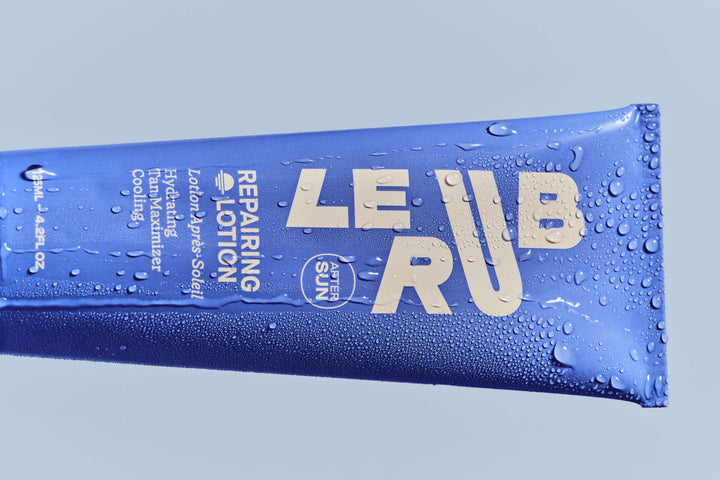The sun dazzles but can also damage - it’s the harsh truth that sometimes make a sunny day feel like a guilty pleasure. Using our mineral sunscreen, made with non-nano zinc oxide, means it doesn’t have to. Embracing one into your daily skincare regime means full, broad-spectrum protection from the sun’s harmful ultraviolet (UV) rays A and B (that’s all of them!) UV damage, as we all know, can lead to sunburn and skin cancer as well as premature aging, redness and pigmentation.
Le Rub made a conscious choice for your health and our magnificent planet to use non-nano zinc oxide only. It’s the safest sunscreen ingredient available and the only active sunscreening agent we use. Zinc oxide works by shielding the skin from the sun. It acts like a physical barrier, bouncing back the UV rays. No fear here, just fun in the sun.
What Are The Benefits of Using A Zinc Oxide Mineral Sunscreen?
As concerns continue to grow around the toxic impact of some chemical filters and nanoparticles, mineral sunscreens are under the microscope. This is important because while some mineral sunscreens incorporate chemical filters, Le Rub remains committed to pure mineral formulations.
We use skin-safe and reef-safe non-nano zinc oxide only. It’s our star player ingredient deserving of the spotlight. As one of the only ingredients deemed safe by the U.S. Food and Drug Administration (FDA), it has never reached the bloodstream. It’s also biodegradable and safer for marine life. We think that’s the future for mindful, modern and super-effective sun protection. Don’t you?
How Does Zinc Oxide Work As A Sunscreen?
Let’s break it down. Zinc oxide is a naturally occurring mineral that provides broad-spectrum protection against both UVA and UVB rays. UVA rays can burn the first layer of skin, while UVB rays penetrate the middle layer of skin and can cause cancerous spots known as melanoma. Chemical sunscreens absorb the UV rays, whereas zinc oxide reflects the rays back off the skin.
Why We Opted Out of Chemical Filters
Studies show that some of the most common chemical filters used in sunscreens could be hormone disruptors and are showing up in the bloodstream. They have also been proved to damage marine life. Hawaii and Key West Florida (areas without a high turnover of water) have banned the ingredients octinoxate and oxybenzone, since 2021. That’s because they have been found to damage developing coral and harm fish and wildlife. Palau, in the Pacific, forbids ‘reef-toxic’ sunscreens containing one of any ten prohibited chemical ingredients, and parts of Mexico require ‘reef-safe’ sunscreen too.
In humans, oxybenzone was found in the urine of 97 percent of 2500 people tested by the US Centers for Disease Control and Prevention in 2008. Further studies have found the chemical in breast milk. Here’s a quick reminder that non-nano zinc oxide has never been found to enter the bloodstream.
Non-Nano Zinc Oxide Is The Safest Sunscreen Ingredient Available
Chemical sunscreens were invented a hundred years ago, in the 1920’s. Of the 16 active ingredients that the FDA said were safe in 1999, only two were considered “safe and effective” twenty years later. Those two ingredients are “non-nanotized” zinc oxide and titanium dioxide. Le Rub doesn’t use titanium dioxide, but more on that below.
What Does Nano and Non-Nano Even Mean?
It’s all about size. Nano and non-nano particle terms are used to define the size of zinc oxide and titanium dioxide in the formulation of mineral sunscreens. Le Rub uses non-nano zinc oxide only. That means non-nano particles, which are 100, nanometer in diameter, or more.
Most mineral sunscreens (and largely those containing titanium dioxide) contain finely milled nanoparticles, which are less than 100 nanometers. That’s one-billionth of a meter, in case you were wondering, and can easily slip into our skin and bloodstream.
Although titanium dioxide is considered safe in its non-nano form, the use of nano-sized particles has raised concerns about their potential toxicity and ability to enter the bloodstream. Zinc oxide, however, can be used in non-nano form, and is a skin-safe, reef-safe alternative to chemical sunscreen and mineral sunscreen made with titanium dioxide.
Zinc Oxide Is Gentle On Sensitive Skin
So we know that our non-nano zinc oxide is skin-safe, reef-safe and sustainable. It’s also sensational for sensitive skin. It’s an ingredient often used in skincare to treat rosacea and eczma and so zinc oxide-based sunscreens are actually recommended for sensitive skins. Unlike some chemical filters that can cause irritation, zinc oxide is non-irritating and soothing, and so suitable for those with delicate skin conditions.
Here’s something strange. Some chemical filters can actually break down when exposed to sunlight, which seems a little counteractive to us. Zinc oxide however is much more helpful. Known for its photostability properties, zinc oxide stays calm under pressure. Unlike some chemical ingredients, it remains stable to provide consistent protection over extended periods of sun exposure. Seems like a great idea for a sunscreen! At Le Rub, we also pick from a melting pot of high-quality ingredients to provide broad-spectrum sun-protection and hydrated, happy and healthy skin.
Dive deeper into our journey by following us on Instagram. From exclusive content to behind-the-scenes fun, it’s all happening over there!















